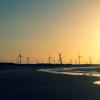
Options Winter 2021: Renewable energies such as wind power will be increasingly important for a net-zero future. IIASA participated in a study that looked at the impacts of wind power expansion in Brazil and explored possibilities to reduce the environmental risks.
As more countries try to reach net carbon neutrality, the use of renewable energies like wind power have also increased. Brazil has seen a ten-fold increase in wind power capacity in the last decade and plans to double that by 2029.
Although wind power has a relatively small carbon footprint, its infrastructure expansion has significant land-use impacts. IIASA researcher Aline Soterroni contributed to a study that explored the land-use impacts of Brazil’s wind power development in the past and possibilities for reducing environmental risks from future wind power expansion. Currently, most of Brazil’s onshore wind parks are concentrated in ecosystems prone to degradation, desertification, and species extinction such as an understudied Brazilian ecoregion known as the Caatinga.
“The Caatinga biome in Brazil is the largest and most diverse dry forest of the Americas. Most current and planned wind farms are in this biome, which greatly overlaps with biodiversity priority areas,” explains Soterroni.
The study shows that future wind power deployment can be fully integrated with human-altered lands. Resources for this are available and would reduce further impacts in vulnerable areas.
“In Brazil, wind parks are sometimes a sensitive subject as landowners have historically not been properly compensated for the use of their land. This makes the issue a bit more complicated. Further research may be needed to consider the tradeoffs between clean energy, biodiversity preservation, and socioeconomic goals,” concludes lead researcher Olga Turkovska from the University of Natural Resources and Life Sciences (BOKU), Vienna.
By Neema Tavakolian
